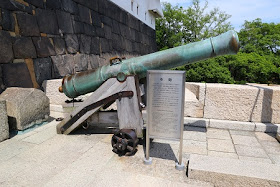I visited Osaka Castle to see biological impacts of Fukushima No.1 nuclear power plant accident. Though I have visited various places in Japan to see the health consequences of the accident, I have never found any effect against creatures in Japan.
Osaka Castle, located in Osaka Castle Park (270ac), is a symbol of Osaka. Osaka Castle is where Toyotomi Hideyoshi aimed to unify Japan as a nation. The history of this castle is extremely dramatic. A lot of stories related to this castle are still being told and written today. 1) Osaka Castle was constructed about 400 years ago. It was badly damaged twice by war. Each time, nearly the entire construction was burned to the ground. 2) The first Osaka Castle was built between 1583 and 1599 by Toyotomi Hideyoshi. Its size was about five times the size of the present castle. Unfortunately, every building was burned down in the Summer War of Osaka between Toyotomi and the Tokugawa shogun in 1615.
3) The second Castle was built between 1620 and 1629 by the second Shogun Tokugawa Hidetada and the third Shogun Tokugawa Iemitsu. The main tower was built in 1626, but it burned down due to a lightning strike in 1665. Most of the other buildings of the Castle were burned down during the Meiji restoration (The battle between Tokugawa Shogunate army and the Meiji government army in 1868). Only 13 buildings remain to this day and are designated as National Important Cultural Assets by the Japanese Government. 4) The present main tower was built in 1931, financed by donations from the citizens of Osaka.
So I visited Osaka Castle for people watching. Fortunately, I couldn't find any impact of the nuclear power plant accident. It seems that there is no problem for childbirth and child-rearing in Osaka prefecture, Japan.
Posted by Yoshitaka Kiriake from Japan on August 11, 2015.
豊臣秀吉が築き上げた大阪城は夏の陣で焼失し、徳川幕府によって再築されましたが落雷により再び焼失しました。現在の天守閣は鉄筋コンクリートで再現されていますが豊臣秀吉が築いた天守閣は現在の5倍の大きさでした。
These pictures were taken on June 2015.
Osaka Castle
Osaka Castle
大阪城
Aoyamon Gate
青屋門
Google map
About Osaka Castle
Source http://www.osaka-info.jp/en/facilities/cat11/post_269.html
There is a museum inside the castle.
About Osaka Castle Museum
Osaka Castle Museum
A Signal Gun or Noon Marker
号砲
Moat
This castle has two moats, an inner moat and an outer moat.
Sightseeing Cruise on the moat.
Stone wall
This stone walls of the Castle were built between 1620 and 1629. The length of the wall is about 12 km in all, and its highest point is 32m in height, measured from the bottom of the moat. It is the highest in Japan. It consists of about one million granite stones.
Shinkansen
Japanese foods are good and safe.
Because of stricter food safety law by Japanese government, we have no worry about foods.
Ekiben or Bento ; Lunch box
駅弁
Takoyaki : Grilled octopus-filled balls made of pancake batter
たこやき
Negiyaki
ネギ焼き
Kushikatsu
串カツ
4 years have passed since Fukushima Daiichi nuclear power plant accident. I have visited various places of Japan to see the health consequence of the accident.
Fortunately I have never found any impacts by the accident among Japanese creatures. As far as I know, nobody has health problem which is caused by the accident in Japan.
Our Prime Minister Abe assures that "The situation is under control. The influence of the contaminated water is completely blocked within Fukushima. There are no health-related problems until now and there will never be health problems." He also said that "Tokyo is 250 kilometers away from Fukushima, and the kind of danger that you imagine does not exist in Tokyo. Tokyo is a very safe city."
As PM Abe said, Osaka Prefecture is very far away from Fukushima, people in there have no concern about the nuclear power plant accident. People in there have already forgotten the accident, because they think radioactive materials cannot reach there.
We know there is no problem for childbirth and child rearing in Osaka Prefecture. So people in there have no concern about the accident.
I continue to visit various places in Japan to see the effects of the accident, because I can meet various creatures which are more sensitive to radioactive materials from the environment. It is important to see their health for our safety.
Fortunately I have never found any impacts by the accident among Japanese creatures. As far as I know, nobody has health problem which is caused by the accident in Japan.
Our Prime Minister Abe assures that "The situation is under control. The influence of the contaminated water is completely blocked within Fukushima. There are no health-related problems until now and there will never be health problems." He also said that "Tokyo is 250 kilometers away from Fukushima, and the kind of danger that you imagine does not exist in Tokyo. Tokyo is a very safe city."
As PM Abe said, Osaka Prefecture is very far away from Fukushima, people in there have no concern about the nuclear power plant accident. People in there have already forgotten the accident, because they think radioactive materials cannot reach there.
We know there is no problem for childbirth and child rearing in Osaka Prefecture. So people in there have no concern about the accident.
I continue to visit various places in Japan to see the effects of the accident, because I can meet various creatures which are more sensitive to radioactive materials from the environment. It is important to see their health for our safety.























0 件のコメント:
コメントを投稿